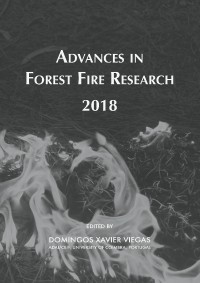Please use this identifier to cite or link to this item:
https://hdl.handle.net/10316.2/44679| Title: | Numerical simulation of low-intensity fire spread in pine litter | Authors: | Mueller, Eric V. Campbell-Lochrie, Zakary Mell, William Hadden, Rory M. |
Keywords: | numerical modeling;flame spread;fuel structure;flow | Issue Date: | 2018 | Publisher: | Imprensa da Universidade de Coimbra | Journal: | http://hdl.handle.net/10316.2/44517 | Abstract: | Detailed physics-based models of wildland fire behavior have shown utility as a tool for investigating the physical drivers of fire spread. However, the continued development of such models requires extensive testing against robust experimental measurements. This remains an outstanding challenge for the research community. A particular application space of interest is the simulation of low-intensity fires, in either still-air or backing fire conditions, as such models have been tested relatively little for such scenarios. A numerical tool capable of properly representing the relevant physics is valuable for understanding the impact of prescribed fire activities, which are often carried out in these conditions. Therefore, ongoing efforts are being undertaken to assess the ability of a detailed physics-based model to simulate fire spread in pine needle litter in still air. Particular focus is placed on the representation of flow within the fuel bed and its effect on fire behavior. The experimental data necessary for model testing was obtained from bench-scale flame spread experiments on a 1.5 m long table. The outputs included both global observations of fire behavior and point measurements of physical processes within the fuel bed (e.g. flow). Numerical modeling was conducted with a computational fluid dynamics model – the Fire Dynamics Simulator – using a multiphase formulation to represent the vegetation. Modifications were implemented in FDS to improve the representation of vegetation, particularly related to thermal degradation in the char oxidation stage. Maintaining a constant fuel load, fuel bed bulk densities of 11 kg·m-3 and 20 kg·m-3 were tested and compared. Results show that, for the same fuel loading, there is a lower limit to the bulk density, for which the fire will not spread. While this limit will exist in reality, experimental results suggest that the model over-predicts its magnitude. This appears to be linked to the flow within the bed, as the lower bulk density case resulted in more entrainment, and thus greater convective cooling ahead of the fire front. Further, flow measurements within the bed show that the model is not adequately representing the removal of fuel, and thus increased flow, behind the fire front. In order to more directly assess the numerical representation of the fluid dynamics within the fuel bed, a heated wind tunnel has been constructed. Flow and convective heating through various fuel arrangements and compositions are being tested. This is aiding in the evaluation of the limits of these submodels, particularly as they apply to low-intensity fire spread in litter fuels. | URI: | https://hdl.handle.net/10316.2/44679 | ISBN: | 978-989-26-16-506 (PDF) | DOI: | 10.14195/978-989-26-16-506_162 | Rights: | open access |
| Appears in Collections: | Advances in forest fire research 2018 |
Files in This Item:
| File | Description | Size | Format | |
|---|---|---|---|---|
| numerical_simulation_of_low-intensity_fire.pdf | 679.46 kB | Adobe PDF |  |
Items in DSpace are protected by copyright, with all rights reserved, unless otherwise indicated.
